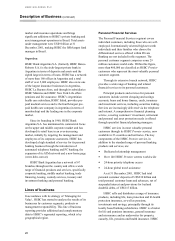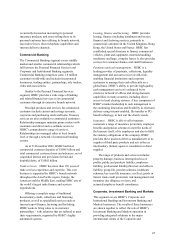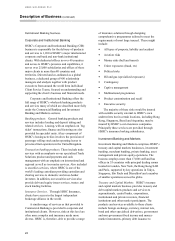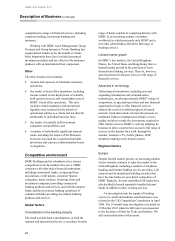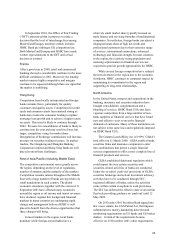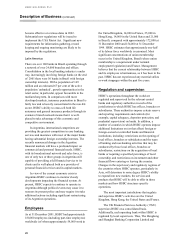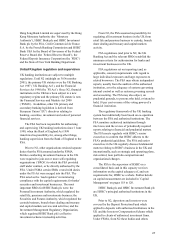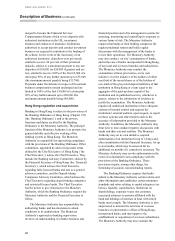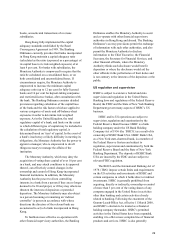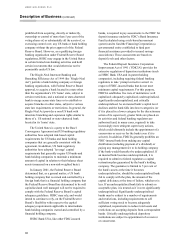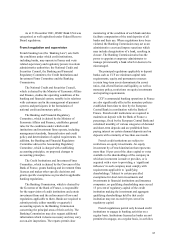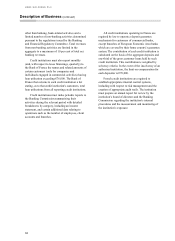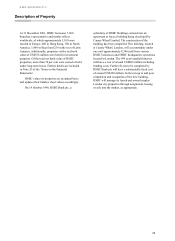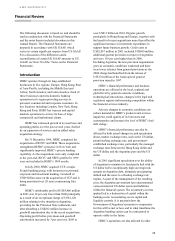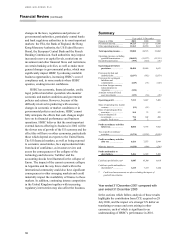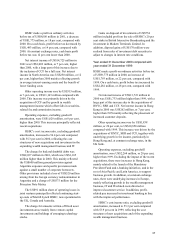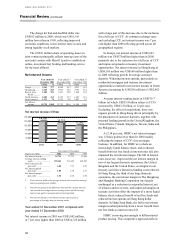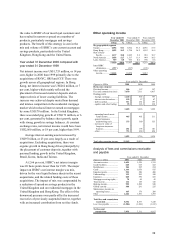HSBC 2001 Annual Report Download - page 32
Download and view the complete annual report
Please find page 32 of the 2001 HSBC annual report below. You can navigate through the pages in the report by either clicking on the pages listed below, or by using the keyword search tool below to find specific information within the annual report.
HSBC HOLDINGS PLC
Description of Business (continued)
30
prohibited from acquiring, directly or indirectly,
ownership or control of more than 5 per cent of the
voting shares of, or substantially all the assets of, or
exercising control over, any US bank or bank holding
company without the prior approval of the Federal
Reserve Board. However, as a qualifying foreign
banking organisation under Federal Reserve Board
regulations, HSBC may engage in the United States
in certain limited non-banking activities and hold
certain investments that would otherwise not be
permissible under US law.
The Riegle-Neal Interstate Banking and
Branching Efficiency Act of 1994 (the ‘Riegle-Neal
Act’ ) permits a bank holding company or foreign
banking organisation, with Federal Reserve Board
approval, to acquire a bank located in a state other
than the organisation’s US ‘home’ state, subject to
certain restrictions, and a national or state-chartered
bank to merge across state lines or to establish or
acquire branches in other states, subject to various
state law requirements or restrictions. In general, the
Riegle-Neal Act provides a non-US bank with
interstate branching and expansion rights similar to
those of a US national or state-chartered bank
located in its ‘home’ state.
The United States is a party to the Basel
Convergence Agreement and US banking regulatory
authorities have adopted risk-based capital
requirements for US banks and bank holding
companies that are generally consistent with the
agreement. In addition, US bank regulatory
authorities have adopted ‘leverage’ capital
requirements that generally require US banks and
bank holding companies to maintain a minimum
amount of capital in relation to their balance sheet
assets (measured on a non-risk-weighted basis).
In January 2001, the Federal Reserve Board
determined that, as a general matter, a US bank
holding company that is owned and controlled by a
foreign bank that is a financial holding company that
the Federal Reserve Board has determined to be well
capitalised and well managed will not be required to
comply with the Federal Reserve Board’ s capital
adequacy guidelines. HSBC may rely, and would
intend to continue to rely, on the Federal Reserve
Board’s flexibility with respect to the capital
adequacy requirements applicable to intermediate
bank holding companies owned and controlled by a
financial holding company.
HSBC Bank USA, like other FDIC-insured
banks, is required to pay assessments to the FDIC for
deposit insurance under the FDIC’s Bank Insurance
Fund (calculated using a risk-based assessment
system) and to fund the Financing Corporation (a
governmental entity established to fund past
financial assistance provided to insured savings
associations). These assessments are based on
deposit levels and other factors.
The Federal Deposit Insurance Corporation
Improvement Act of 1991 (‘FDICIA’ ) provides for
extensive regulation of depository institutions (such
as HSBC Bank USA and its parent holding
companies), including requiring federal banking
regulators to take ‘prompt corrective action’ in
respect of FDIC-insured banks that do not meet
minimum capital requirements. For this purpose,
FDICIA establishes five tiers of institutions: well
capitalised; adequately capitalised; undercapitalised;
significantly undercapitalised; and critically
undercapitalised. As an insured bank’s capital level
declines and the bank falls into lower categories (or
if it is placed in a lower category by the discretionary
action of its supervisor), greater limits are placed on
its activities and federal banking regulators are
authorised (and, in many cases, required) to take
increasingly more stringent supervisory actions,
which could ultimately include the appointment of a
conservator or receiver for the bank (even if it is
solvent). In addition, FDICIA generally prohibits an
FDIC-insured bank from making any capital
distribution (including payment of a dividend) or
paying any management fee to its holding company
if the bank would thereafter be undercapitalised. If
an insured bank becomes undercapitalised, it is
required to submit to federal regulators a capital
restoration plan guaranteed by the bank’s holding
company. The guarantee is limited to 5 per cent of
the bank’s assets at the time it becomes
undercapitalised or, should the undercapitalised bank
fail to comply with the plan, the amount of the
capital deficiency at the time of failure, whichever is
less. If an undercapitalised bank fails to submit an
acceptable plan, it is treated as if it were significantly
undercapitalised. Significantly undercapitalised
banks may be subject to a number of requirements
and restrictions, including requirements to sell
sufficient voting stock to become adequately
capitalised, requirements to reduce total assets and
restrictions on accepting deposits from correspondent
banks. Critically undercapitalised depository
institutions are subject to appointment of a receiver
or conservator.


